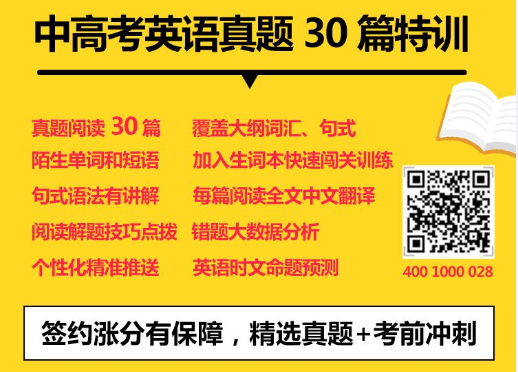-
重大利好!高考延期1个月!高考英语140+是怎么做到的?英语成绩就是提高不了怎么
2020-03-31
-
2020-03-31
-
2020-03-31
-
2020-03-31
-
2020-03-31
更新时间:2020-03-31浏览:次评论: 条
重大利好!高考延期1个月!高考英语140+是怎么做到的?英语成绩就是提高不了怎么
2020-03-31
2020-03-31
2020-03-31
2020-03-31
2020-03-31
中考英语语法专项复习
句子的种类
考点一 陈述句和疑问句
一、陈述句
用来陈述一件事实或表达说话者看法的句子叫作陈述句,句末用句号表示句子的陈述结束。陈述句分为肯定句和否定句。
|
肯定 句 |
肯定句的基本结构是“主语 + 谓语” |
I play basketball after school. 我放学后打篮球。 |
|
否 定 句 |
(1)完全否定: 常用not;no; no one;nobody;nothing;neither;none; never等词表示否定意义 (2)部分否定: ①用hardly,seldom,few, little等词表示 ②not和both,all,each,every,quite,always等连用表示部分否定 |
None of us have been to Canada. 我们都没去过加拿大。 ①I can hardly see anything in the rain. 在雨中我几乎什么东西也看不见。 ②Not all students come to school by bus. 并非所有的学生都乘公共汽车来上学。 |
二、疑问句
用来表示提问的句子叫作疑问句,句末用问号。疑问句包括一般疑问句、特殊疑问句、选择疑问句和反意疑问句四种。
(一)一般疑问句
|
用法 |
例句 |
|
(1)以系动词be开头的疑问句 |
Are you a student? 你是学生吗? |
|
(2)以助动词开头的疑问句 |
Do you speak French? 你说法语吗? |
|
(3)以情态动词开头的疑问句 |
Can you dance? 你会跳舞吗? |
(二)特殊疑问句
用特殊疑问词引导的疑问句叫作特殊疑问句。特殊疑问词包括疑问代词、疑问副词和由疑问词构成的疑问短语。
|
引导词 |
用法 |
例句 |
|
常用疑 问代词 |
what什么;who谁;whom谁(who的宾格);which哪个(些);whose谁的;疑问代词可以提问主语、谓语、表语或定语。 |
What are you doing? 你在干什么? |
|
常用疑 问副词 |
when何时;where何地;how怎么;why为什么 |
Where are you going tomorrow? 明天你去哪儿? |
|
常用疑 问短语 |
what time什么时刻;how many/much多少;how often多久一次;how soon多久;how long多长时间;how far多远;how old多大(年龄);how big多大 |
—How long have you been here? ——你来这儿多久了? —For 10 minutes. ——十分钟了。 |
(三)选择疑问句
用来在两种或两种以上情况中进行选择的疑问句叫作选择疑问句。答语不能用Yes/No回答,而应从问句中选择一种情况进行回答。
|
用法 |
例句 |
|
一般选择疑问句的构成:一般疑问句+or+被选择的内容 |
Are you a teacher or a doctor? 你是一名老师还是一名医生? |
|
特殊选择疑问句的构成:特殊疑问句+A or B? |
Which do you like better, tea or coffee? 茶和咖啡你更喜欢哪一个? |
(四)反意疑问句
附在陈述句后对陈述内容进行反问的句子叫作反意疑问句,也叫附加疑问句。反意疑问句前一部分是陈述句,后一部分是简短问句。陈述部分用逗号结尾,反问部分用问号结尾。例如:
It’s a nice day, isn’t it?
天气不错,不是吗?
1. 基本结构:前肯后否;前否后肯。例如:
①We have talked about it, haven’t we?
我们已经谈过这件事了,不是吗?
②Mr. Smith isn’t at home, is he?
史密斯先生不在家,是吗?
|
用法 |
例句 |
|
(1)疑问部分的主语必须与陈述部分的主语一致;当陈述部分的主语是名词或代词时,疑问部分要用相应的人称代词 |
Mr. Black comes from the UK, doesn’t he? 布莱克先生来自英国,不是吗? |
|
(2)疑问部分要与陈述部分的时态保持一致 |
Tom went to the cinema yesterday, didn’t he? 汤姆昨天去看电影了,不是吗? |
|
(3)答语是肯定的用 “Yes”; 答语是否定的用 “No”。前否后肯的反意疑问句yes译为“不”,no译为“是的” |
—Ann didn’t come to school last week, did she? —安上周没来上学,对吗? —No, she didn’t. She was ill. ——是的,她没来。她生病了。 |
2. 反问句中的特殊形式
|
用法 |
例句 |
|
(1)陈述句是I am. . . ,反意疑问句用aren’t I |
I’m your best friend, aren’t I? 我是你最好的朋友,不是吗? |
|
(2)当陈述部分是there be结构时,反意疑问句部分用there |
There are many birds in the tree, aren’t there? 树上有许多鸟,不是吗? |
|
(3)当陈述部分的主语是指示代词this,that时,反意疑问句部分的主语用it;主语是these或those时,反意疑问句部分的主语用they |
①This is an English car, isn’t it? 这是一辆英国汽车,不是吗? ②These are Russian planes, aren’t they? 这些是俄罗斯飞机,不是吗? |
|
(4)当陈述部分含有never/nothing/none/no one/seldom/hardly/few/little等否定副词时,反意疑问句用肯定形式 |
She has never been abroad, has she? 她从来没有出过国,对吗? |
|
(5)如果陈述部分含有由否定前缀im-,dis-,un-等构成的否定意义的词,则陈述部分作肯定处理,反意疑问句仍用否定形式 |
Mary is unhappy, isn’t she? 玛丽不高兴,是吗? |
|
(6)陈述句主语是不定代词something/anything/everything/nothing等时,反意疑问句中代词用it |
Nothing is wrong with the computer, is it? 计算机没什么问题,是不是? |
|
(7)陈述句主语为somebody/someone/anybody/anyone/everybody/everyone等时,反问句中代词用they或he,注意问句动词的数应与they/ he保持一致 |
Everyone has known the news, hasn’t he? /haven’t they? 大家都知道这个消息了,是不是? |
|
(8)祈使句的反意疑问句 ①祈使句是肯定形式,其反意疑问句用will you或 won’t you皆可。 ②祈使句是否定形式,其反意疑问句通常只用will you构成。 ③以Let开头的祈使句构成 反意疑问句时, Let’s用shall we构成反意疑问句, 其他均用will you。 |
①Be sure to write to us, will/won’t you? 一定要给我们写信,好吗? ②Don’t smoke in the meeting room, will you? 请不要在会议室抽烟,好吗? ③Let’s take a walk after supper, shall we? 晚饭后我们去散步,好吗? ④Let the boy go first, will you? 让那男孩先走,好吗? |
【温馨提示】
陈述句是I think/I suppose/I believe/I consider等结构时,问句一般与从句保持一致。注意“否定前移”。
①I think you can do it better next time, can’t you?
我觉得你下次可以做得更好,是不是?
②I don’t believe there will be robots at people’s homes, will there?
我相信人们的家里不会有机器人的,会有吗?
考点二 感叹句
|
类别 |
结构 |
例句 |
|
以what 引导 |
What + a/an+adj. +单数可数名词 + 主语 + 谓语! |
What a beautiful mountain it is! 多么美丽的山啊! |
|
What+adj. +复数可数名词 + 主语 + 谓语! |
What great inventions he has made! 他的发明多么伟大啊! |
|
|
What+adj. +不可数名词 + 主语 + 谓语! |
What bad weather it is today! 今天的天气多么糟糕啊! |
|
|
以how 引导 |
How+adj. +a/an+可数名词单数+主语+谓语! |
How clever a boy he is! 多么聪明的男孩! |
|
How+adj. /adv. +主语+谓语! |
How quickly Tom runs! 汤姆跑得真快! |
【巧学妙记】
感叹句,并不难,what或how摆在前。
强调名词用what,其余how很简单。
名词若是可数单,前带冠词a或an。
主语谓语放在后,省略也是很常见。
考点三 祈使句
祈使句表达说话人对对方的劝告、叮嘱、建议、请求或命令等。主语you通常省略,谓语动词用原形,句末用感叹号或句号。表达请求或劝告时,祈使句句末或句首可以加上please表示委婉的语气
一、肯定祈使句的表现形式
|
Do型 |
动词原形(+宾语)+其他成分。 |
Please have a seat. 请坐。 |
|
Be型 |
Be+表语(名词或形容词)+其他成分。 |
Be quiet! 安静! |
|
Let型 |
Let+宾语+动词原形+其他成分。 |
Let me help you. 让我帮助你。 |
二、否定祈使句的表现形式
(1)Do型和Be型的否定式都是在句首加don’t构成。例如:
①Don’t forget me! 不要忘记我!
②Don’t be late for school! 上学不要迟到!
(2)Let型的否定式有两种:“Don’t +let+宾语+动词原形+其他成分”和“Let+宾语+not+动词原形+其他成分”。例如:
Don’t let him go. /Let him not go. 别让他走。
(3)有些可用no开头,用来表示禁止性的祈使句。例如:
No smoking! 禁止吸烟!

考点四 倒装句
英语句子一般主语在前,谓语在后。但有时因为语法结构的要求或为了表达特殊的强调部分,会把句中的谓语提到主语前面。这种句子叫作倒装句。
倒装句的常见句式:
一、There be句型
There be句型表示“存在”,主语在be的后面。例如:
There is some coffee in the cup. 杯中有些咖啡。
1. there be与have的区别
(1)There be结构表示“某地有某人/物”,强调客观存在。
(2)have(has, had)表示“(某人)拥有某物”,强调所属关系。例如:
Mr. Bush has two daughters. 布什先生有两个女儿。
2. There be句型的句式变化
(1)对There be句型中的主语提问用:What’s + 地点状语/时间状语? 例如:
There are many birds in the forests.
树林里有许多鸟。
→What’s in the forests? 树林里有什么?
(2)对There be句式中数量的提问
①How many + 可数名词 + are there + 地点状语?
②How much + 不可数名词 + is there + 地点状语?
(3)There be句型中,反意疑问句的附加部分应用there。
例如:
There’s no air on the moon, is there?
月球上没有空气,是吗?
二、So+助动词/系动词/情态动词+主语
表示与上文中所述肯定情况相同。例如:
─Jack likes rice for lunch. ——杰克午饭喜欢吃米饭。
─So do I. ——我也是。
【温馨提示】
“So+主语+助动词/系动词/情态动词”表示“确实如此”,表示对上文所述情况的认可和肯定。例如:
─Jack likes rice for lunch. ——杰克午饭喜欢吃米饭。
─So he does. ——是啊。(他确实喜欢)
三、Neither+助动词/系动词/情态动词+主语
表示与上文中所述否定情况相同。例如:
─Peter has never been to Canada.
——彼得从未去过加拿大。
─Neither have I. ——我也没有去过。
四、以副词开头的倒装句
以here, there, out, in, down, away等表示方位的副词开头的句子中,如果主语是名词,要用倒装句。谓语动词的形式由倒装句句尾的主语决定。例如:
There comes the bus. 公交车来了。
Here are the results of the test. 测试结果出来了。
考点五 主谓一致
主谓一致是指谓语动词和主语在人称和数上保持一致,遵循三个原则:①语法一致 ②意义一致 ③就近一致
一、语法一致
是指主语和谓语在语法形式上保持一致,即主语是单数形式,谓语动词用单数形式;主语是复数形式,谓语动词也用复数形式。
1. 主语是以下情况时,谓语动词用单数形式:
不可数名词、可数名词单数、单数代词、不定式(短语)、动名词(短语)、从句等。例如:
Coffee is more popular in western countries.
咖啡在西方国家更流行。
Surfing sounds really interesting.
冲浪听起来真的很有趣。
2. 主语是可数名词复数、复数代词,谓语动词用复数形式。例如:
Some boys are playing in the park.
一些男孩在公园里玩。
They have been swimming for 2 hours.
他们已经游泳两个小时了。
3. 以and和both. . . and. . . 连接的并列主语是两个或两个以上的人或事物时,谓语动词用复数形式;若并列主语表示同一人或事物(and后的主语前没有冠词),则谓语动词要用单数形式。例如:
Both Linda and her sister are students.
琳达和她妹妹都是学生。
The book and cover is designed by Mike.
书和封面都是迈克设计的。
4. 主语后跟下列词汇时,谓语动词的数和主语保持一致:
with, along with, like, except, besides, as well as, together with, including, no less than, rather than, as much as等。
例如:
Jenny with her classmates reads English every morning.
珍妮和同学们每天早上都读英语。
5. a number of + 复数名词作主语时,谓语动词用复数形式;the number of + 复数名词作主语时,谓语动词用单数形式。
例如:
The number of doctors in the hospital is about 200 and a number of them are women doctors.
这家医院大约有200名医生,很多是女医生。
6. “one of + 名词复数 + 单数谓语动词”表示“……之一”。
例如:
One of my pen pals is from Sydney.
我的笔友中有一位来自悉尼。
7. none of 后面只能跟可数名词的复数形式,谓语动词用单数、复数都可以。例如:
None of those books are/is good.
那些书中没有一本是好的。

二、意义一致
是指谓语动词形式要与主语意义上的单复数形式保持一致。例如:
1. 有些集体名词如family, class, public, group等作主语时,
(1)若表示一个集体,谓语动词用单数形式;
(2)若表示集体中的成员,谓语动词用复数形式。
例如:
①Our class is on the third floor. 我们班在三楼。
②Our class are going to visit the museum tomorrow.
明天我们班要去参观博物馆。
2. 有些集体名词如people, police等,表示复数意义,谓语动词只用复数形式;有些名词如news, means, politics等以-s结尾,但表示单数意义,谓语动词用单数形式。例如:
The trousers don’t fit me. They are too short.
这条裤子不适合我。它太短了。
3. 复数名词表示时间、长度、重量、价格、距离等意义时,谓语动词用单数形式。例如:
Fifty years is a long time in one’s life.
五十年在人的一生中是很长的一段时间。
Three dollars is enough for a pen.
三美元足够买支钢笔了。
4. “the + 形容词”可以表示一类人,作主语时谓语动词用复数形式。例如:
The old need more care. 老人更需要关爱。
三、就近一致
是指由部分短语引导主语,谓语动词根据靠近它的主语名词决定单复数形式。
1. There be, Here be句式的就近原则。例如:
There is a book and some pencils on the desk.
桌子上有一本书和几支铅笔。
There are some pencils and a book on the desk.
桌子上有几支铅笔和一本书。
2. Either. . . or. . . , Neither. . . nor. . . , Not only. . . but also. . . 引导主语时的就近原则。例如:
Either you or your brother has forgotten to turn off the light before going to bed.
不是你就是你弟弟睡觉前忘了关灯。
Not only Tom but (also) his parents enjoy swimming.
不仅汤姆,而且他的父母也都喜欢游泳。
中考英语语法专项复习
句子的种类习题
Ⅰ. 单项选择
1. —Is this a Chinese book or an English book?
—Oh, _____ .
A. Yes, it is
B. No, it isn’t
C. An English book
D. A music book
2. —When I was five, I drew very well.
— _____ .
A. So did I
B. So was I
C. So I was
D. So I did
3. —A subway will be built in our hometown before 2015.
— _____ ! Will it pass my house?
A. What an excited news
B. What exciting news
C. How exciting news
4. —How _____ will the boss be back?
—In these days.
A. far
B. soon
C. long
D. often
5. —It’s sunny today. Let’s go mountain climbing, _____ ?
—Good idea!
A. shall we
B. will you
C. won’t you
6. They can hardly speak English, _____?
A. can’t they
B. won’t they
C. can they
D. will they
7. —I have never been to Hawaii. What about Mike?
— _____ .
A. So has he
B. So he does
C. Neither he has
D. Neither has he
8. — _____ interesting the storybook is!
—Yes. I have read it twice.
A. What a
B. What
C. How a
D. How
9. _____ wonderful news report he wrote! All of us were proud of him.
A. What a
B. What
C. How
D. How a
10. — _____ today!
—Yes. Shall we have a picnic in the open air?
A. What fine weather is
B. How fine weather it is
C. What a fine weather it is
D. How fine the weather is
11. —_____ is it from Leshan to Chengdu?
—I’m not sure, but it takes about two hours to get there by bus.
A. How soon
B. How far
C. How fast
12. — _____ do you speak English so well?
—Because I practice it with my partner every day.
A. Why
B. When
C. Who
13. —How much is the pair of shoes?
—Twenty dollars _____ enough.
A. is
B. are
C. am
14. Don’t make so much noise. Lily, _____?
A. do you
B. don’t you
C. will you
D. won’t you
15. —Mr. Wang’s never been to Canada, has he?
— _____ . He went there on business last week.
A. No, he hasn’t
B. Yes, he has
C. No, he has
D. Yes, he hasn’t
16. Neither my father nor my mother _____ rock music. They think that it’s too _____ .
A. like; noise
B. likes; noise
C. like; noisy
D. likes; noisy
17. — Li Mei usually helps others, _____?
— Yes, she is kind-hearted.
A. does she
B. is she
C. doesn’t she
18. —I haven’t seen the film Pirates of the Caribbean: On Stranger Tides.
— _____ .
A. Neither have I
B. So have I
C. Neither I have
D. So I have
19. —I hope the summer vacation will come soon.
— _____ . It’s really relaxing.
A. So I did
B. So I do
C. So did I
D. So do I
20. —Alice had nothing for breakfast this morning, _____ ?
—No. She got up too late.
A. had she
B. hadn’t she
C. did she
D. didn’t she
21. Hey, Nick. _____ comes the last bus! Hurry up, or we’ll have to walk home.
A. This
B. There
C. That
D. It
22. The number of books in the bookshop is about 10, 000 and a number of them _____ about science.
A. is
B. was
C. are
D. were
Ⅱ. 句型转换
1. Martin used to give his mother a lot of trouble. (改为否定句)
Martin _____ ______ to give his mother a lot of trouble.
2. Alice has a tennis racket. (改为一般疑问句)
_____ Alice _____ a tennis racket?
3. The students will learn the group dance on the school playground. (对画线部分提问)
_____ _____ the students learn the group dance?
4. The beach is a nice place for tourists. (改为感叹句)
_____ _____ nice place the beach is for tourists!
5. She hardly knew how to solve this math problem. (改为反意疑问句)
She hardly knew how to solve this math problem, _____ _____ ?
6. We will turn off the lights for an hour on Earth Day. (对画线部分提问)
_____ _____ we turn off the lights for an hour?
Ⅰ. 单项选择
1.【解析】选C。对于选择疑问句的回答,只能选其一,故选C。
2.【解析】选A。由上下文主语不一致知用倒装语序,再由上一句的时态为一般过去时,且谓语动词为实义动词drew, 故倒装语序中用助动词did。因此答案为A。
3.【解析】选B。news是不可数名词,故用what引导感叹句。
4.【解析】选B。由答语是in引导的时间状语,可知用how soon进行提问。
5.【解析】选A。let’s引导的祈使句其反意疑问句用shall we。
6.【解析】选C。hardly是否定副词,故用肯定形式进行反意疑问,故选C。
7.【解析】选D。由上文“我从没去过夏威夷。”是否定内容可知应该用neither引导,再由上下文主语不一致,因此用倒装语序,故选D。
8.【解析】选D。考查感叹句的用法。根据句意:——这本故事书是多么有趣呀!——是的。我已经读了两遍了。可以推知符合“How+形容词+主语+谓语!”的感叹句的结构。故选D。
9.【解析】选A。考查感叹句。结合感叹句结构故先排除D,句中的中心词是可数名词report, how后接中心词应该是形容词。故排除B和C。故选A。
10.【解析】选D。考查感叹句。感叹句的构成①what+ adj. +可数名词复数+(主)+(谓)②what+ a/an+ adj. +可数名词单数+(主)+(谓)③How+ adj. /adv. +(主)+(谓),故选D。
11.【解析】选B。由答语“我不确定,但是乘车去那里大约花费两个小时。”可知对方询问的是从乐山到成都的距离,故用how far进行提问。故选B。
12.【解析】选A。由答语是because引导的原因状语从句可知上文询问的是“你为什么英语说得这么好?”故选A。
13.【解析】选A。表示时间、距离、价格、重量、长度等名词或短语作主语时,通常把它作为一个整体概念,谓语动词用单数。故选A。
14.【解析】选C。考查反意疑问句的用法。否定祈使句的反意疑问句用“will you”,故选C。
15.【解析】选B。由答语第二句“上个周他去那里出差了。”可知王先生去过加拿大。故用Yes, he has. 作答。故选B。
16.【解析】选D。neither. . . nor连接并列主语时谓语动词和最近的主语保持一致;noise“噪音”,是名词,不可被副词too修饰;noisy“嘈杂的;喧闹的”,是形容词,可以被副词too修饰。故选D。
17.【解析】选C。反意疑问句的时态和人称主要由陈述部分决定,同时遵守“前肯后否,前否后肯”的原则。故选C。
18.【解析】选A。由上句是否定情况可排除B、D两项,用neither引导;再由主语不一致可知应该用倒装结构,故选A。
19.【解析】选D。考查so引导的倒装句。根据答句中“它真的非常令人放松”可判定答语表示“我也希望”。若表示后者也具有上文提到的情况,用倒装句so+助动词+主语,由上句的时态是一般现在时态可知选D。
20.【解析】选C。 nothing是否定代词,故反问部分用肯定形式,再由谓语动词是实义动词had,故用助动词did进行反问,故选C。
21.【解析】选B。以here,there开头的句子,且主语是名词时用倒装语序。故选B。
22.【解析】选C。“a number of+复数名词”意为“许多;大量的”,其修饰的短语作主语时,谓语动词用复数形式,再由时态为一般现在时可知答案为C。
Ⅱ. 句型转换
1. didn’t use/used not2. Does; have
3.Where will 4. What a
5. did she6. When will
文章来源于网络,如果侵权请及时联系我们删除,奇速英语全国热线:400-1000-028
中高考真题30篇冲刺详情点击这里了解更多

Unit 2单词 (音标) 1. France n. 法国 2. French adj. 法国的 3. flag n. 旗帜 4. wine n. 葡萄酒 5. tick v. 标记号;打上钩
发布时间:2020-03-26 浏览:105次 评论:条
Unit 3 单词 (音标) 1. blind adj. 瞎的;失明的 2. radio n. 无线电广播 3. programme n. 节目 4. helpful adj. 有用的;有帮
发布时间:2020-03-26 浏览:115次 评论:条
无论是国家教育政策的改革还是新型教育观的大量涌现,都从侧面体现出教育在一个国家发展中占着越来越重要的位置,同时也加紧了家
发布时间:2020-03-26 浏览:188次 评论:条
青少年英语小升初、初升高英语衔接班,不提前准备就晚了。特别是英语学科,尤其是面临小学升初中、初中升高中等大问题。成绩偏下
发布时间:2020-03-26 浏览:100次 评论:条